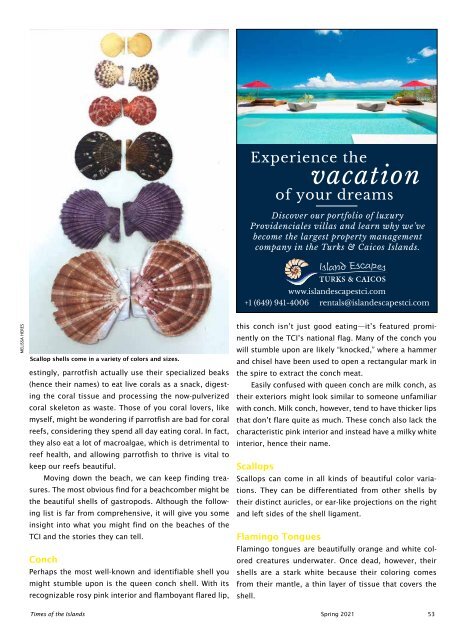Times of the Islands Spring 2021
Presents the "soul of the Turks & Caicos Islands" with in-depth features about local people, culture, history, environment, real estate, businesses, resorts, restaurants and activities.
Presents the "soul of the Turks & Caicos Islands" with in-depth features about local people, culture, history, environment, real estate, businesses, resorts, restaurants and activities.
You also want an ePaper? Increase the reach of your titles
YUMPU automatically turns print PDFs into web optimized ePapers that Google loves.
MELISSA HERES<br />
Scallop shells come in a variety <strong>of</strong> colors and sizes.<br />
estingly, parrotfish actually use <strong>the</strong>ir specialized beaks<br />
(hence <strong>the</strong>ir names) to eat live corals as a snack, digesting<br />
<strong>the</strong> coral tissue and processing <strong>the</strong> now-pulverized<br />
coral skeleton as waste. Those <strong>of</strong> you coral lovers, like<br />
myself, might be wondering if parrotfish are bad for coral<br />
reefs, considering <strong>the</strong>y spend all day eating coral. In fact,<br />
<strong>the</strong>y also eat a lot <strong>of</strong> macroalgae, which is detrimental to<br />
reef health, and allowing parrotfish to thrive is vital to<br />
keep our reefs beautiful.<br />
Moving down <strong>the</strong> beach, we can keep finding treasures.<br />
The most obvious find for a beachcomber might be<br />
<strong>the</strong> beautiful shells <strong>of</strong> gastropods. Although <strong>the</strong> following<br />
list is far from comprehensive, it will give you some<br />
insight into what you might find on <strong>the</strong> beaches <strong>of</strong> <strong>the</strong><br />
TCI and <strong>the</strong> stories <strong>the</strong>y can tell.<br />
Conch<br />
Perhaps <strong>the</strong> most well-known and identifiable shell you<br />
might stumble upon is <strong>the</strong> queen conch shell. With its<br />
recognizable rosy pink interior and flamboyant flared lip,<br />
this conch isn’t just good eating—it’s featured prominently<br />
on <strong>the</strong> TCI’s national flag. Many <strong>of</strong> <strong>the</strong> conch you<br />
will stumble upon are likely “knocked,” where a hammer<br />
and chisel have been used to open a rectangular mark in<br />
<strong>the</strong> spire to extract <strong>the</strong> conch meat.<br />
Easily confused with queen conch are milk conch, as<br />
<strong>the</strong>ir exteriors might look similar to someone unfamiliar<br />
with conch. Milk conch, however, tend to have thicker lips<br />
that don’t flare quite as much. These conch also lack <strong>the</strong><br />
characteristic pink interior and instead have a milky white<br />
interior, hence <strong>the</strong>ir name.<br />
Scallops<br />
Scallops can come in all kinds <strong>of</strong> beautiful color variations.<br />
They can be differentiated from o<strong>the</strong>r shells by<br />
<strong>the</strong>ir distinct auricles, or ear-like projections on <strong>the</strong> right<br />
and left sides <strong>of</strong> <strong>the</strong> shell ligament.<br />
Flamingo Tongues<br />
Flamingo tongues are beautifully orange and white colored<br />
creatures underwater. Once dead, however, <strong>the</strong>ir<br />
shells are a stark white because <strong>the</strong>ir coloring comes<br />
from <strong>the</strong>ir mantle, a thin layer <strong>of</strong> tissue that covers <strong>the</strong><br />
shell.<br />
<strong>Times</strong> <strong>of</strong> <strong>the</strong> <strong>Islands</strong> <strong>Spring</strong> <strong>2021</strong> 53

















